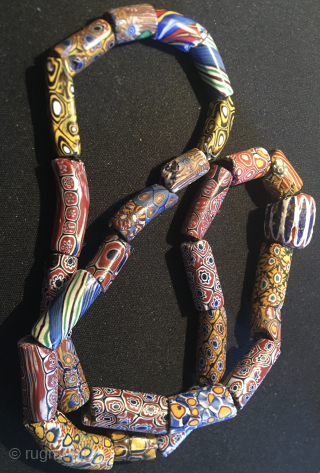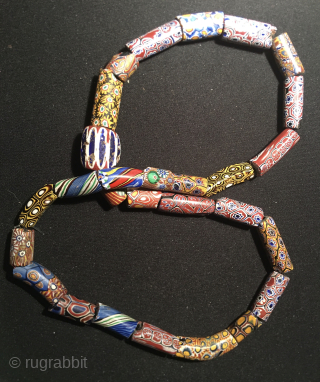Back
28 Murrine beads.
19th-century Venetian Murrine's beads.
"Murrine" beads.
They are antique, datable 1860/1920 and were blown in Venice on the island of Murano.
They were shipped to Western Africa where they were used as trade beads.
Size is cm 1.5 to 2.5. Some are broken.
Please note the very old Venetian 7 layer Chevron, Rosetta or Star glass bead with mysterious red line layer that could be centuries older than the rest. (Check prices online for similar beads.)
This could be a perfect present for your lady!
Murrine is a polychrome coloured pattern well-known to collectors and researchers as “African trade beads”. ...
Murrine mosaic has various section pattern giving the beads the most astonishing appearance.
When you speak about “Murano Glass” you are actually referring to a wide variety of products: everything from micro-beads to huge chandeliers.
In 1291 the Venetian government made an important decision regarding glass production: all glass furnaces in the city had to be moved to the island of Murano. In this way, the risk of fires in the city centre was reduced, and it became easier for the authorities to control the production of glass and protect it from imitations by foreigners.
In 1638 it was decided that only the members of Muranese families were allowed to be glassblowers: glassmaking had become a privilege.
price:
pls inquire
- Home
- Antique Rugs by Region
- Category
- Profiles
- Post Items Free
- Albums
- Benaki Museum of Islamic Art
- Budapest: Ottoman Carpets
- Gulbenkian Museum
- Islamic Carpets. Brooklyn
- Islamic Textiles. Brooklyn
- Konya Museum: Rugs
- MKG, Hamburg
- MMA: Caucasian Carpets
- MMA: Mamluk Carpets
- MMA: Mughal Indian Carpets
- MMA: Ottoman Carpets
- MMA: Safavid Persian Carpets
- MMA: Turkmen Rugs
- McCoy Jones Kilims
- Ottoman textiles. Met
- Philadelphia Museum
- Rugs and Carpets: Berlin
- Seljuqs at the Met
- TIEM, Istanbul: Carpets
- V&A: Classical Carpets
- Vakiflar Carpets: Istanbul
- Baluch Rugs: Indianapolis
- Gallery Exhibitions
- Jaf an Exhibition
- Alberto Levi Gallery
- Andean Textile
- Christie's London: 2016
- Francesca Galloway
- HALI at 40
- ICOC Washington, DC 2018
- Jajims of the Shahsavan
- London Islamic Week April, 2018
- Mongolian Felts
- Navajo Rugs: JB Moore
- Persian Piled Weavings
- SF Tribal & Textile Art Show 2020
- SF Tribal 2019
- Sotheby's: C. Alexander
- Turkish Prayer Rugs
- Turkmen Main Carpets ICOC 2007












